Lightwave Yachts Electrical System
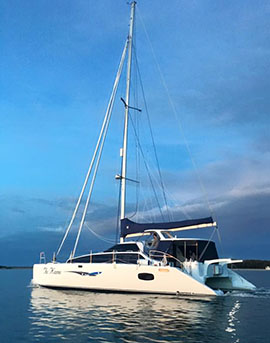 Just about all Australian sailing enthusiasts would be familiar with Lightwave Yachts. The launching of the Lightwave 45 sailing catamaran Tu Kano in May 2016 celebrates their 80th build.
Just about all Australian sailing enthusiasts would be familiar with Lightwave Yachts. The launching of the Lightwave 45 sailing catamaran Tu Kano in May 2016 celebrates their 80th build.
As is the case with the last three Lightwave catamarans, Tu Kano is fitted with a Outback Marine electrical system featuring an Outback manufactured Lithium Ion house battery bank and battery management system.
The success of this type of project relies on taking a system design approach that takes into account the customer expectations and particular use case along with builder requirements and vessel characteristics. The key elements of this design feature the following equipment.
- Outback DC distribution board
- Outback custom electrical panel
- Outback custom engine and helm panel
- Outback battery management controller
- Outback 540 amp hour 12 volt lithium house battery
- Lifeline GPL1400 cranking/reserve battery
- Victron 3000 VA Multiplus inverter charger
- Victron Digital Multi Control panel
- Victron 100/50 MPPT solar controller
- 1000 watts of surface mount solar panels
Credit must go to Lightwave Yachts for their superb craftsmanship and Odyssey Marine Electrical who performed the installation.
| System Design | ||
|
An Outback Marine system design begins with a document that presents an overview and content of the entire electrical system. The document identifies the major electrical system components and shows their basic interconnection. It is used as a planning tool to drive the detail design and supply process. Our system design process is described in this Electrical System Design download. |
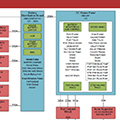 System Overview |
 Electrical Schematic |
| Electrical Cabinet | ||
|
Major electrical system components including the heavy DC distribution board, inverter charger, solar regulator and electrical panels are located in close proximity to each other in a dedicated cabinet that is clean and dry. From this area, cables are routed to the batteries, engines, inverter charger, solar regulator and all sub circuits via the main electrical panel. Ventilation of the cabinet is achieved by a small computer fan that draws air in from the bottom to exit at the top through vents. The large access hatch provides entry for maintenance. A DC Distribution Board (DCD) is the wiring hub for the system where the batteries and all primary DC distribution circuits including the engines, DC electrical panel, inverter charger and solar panels connect. The board uses an industrial strength busbar system with high current fuses to distribute power and maintain proper circuit protection. Remote battery switching is controlled by the Battery Management and Control instrument located at the electrical panel but the physical switches also have manual override capability. |
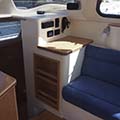 Electrical Cabinet Area |
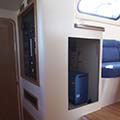 Electrical Cabinet Access |
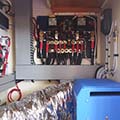 DC Distribution Board |
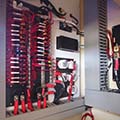 Electrical Panel Installation |
|
| Custom Electrical and Engine Panels | ||
|
The house panel is located on the starboard side in the lower companionway. Flat rocker style circuit breakers control and protect all major DC circuits. Included are heavy circuit breakers for the windlass and sheet winches. Outback electrical panels can accommodate circuit breakers ranging from 5 amps to 300 amps. In this case, special thermal type breakers were required for the sheet winches. At the top right is a mimic panel that indicates the status of the navigation lights. At the top left is the Battery Management Control unit that monitors and controls the lithium house battery and the AGM starting / reserve battery. Circuits that require control from the helm are implemented using waterproof rocker switches. This panel also has a 12 volt outlet and a mimic diagram that indicates bilge pump activity. The engine panel brings together both sets of engine instruments in a balanced port and starboard format. |
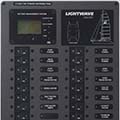 House Panel |
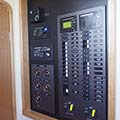 Panel Location |
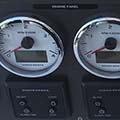 Engine Panel |
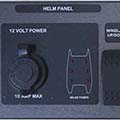 Helm Panel |
|
| Batteries | ||
|
The Lithium Ion house battery is located centrally under the settee at the mast bulkhead. At 75 kilograms it's relatively compact and light weight versus an alternate 216 kilogram AGM battery configuration. Full top access is provided for viewing cell modules and maintenance of the main battery fuse if required. An AGM reserve / starting battery is located next to the Lithium battery. In the unlikely event of a battery failure, the Lithium battery can start the engines or the start battery can service essential house loads. By keeping batteries out of the engine rooms, better weight balance is achieved and the batteries last longer as they are not exposed to higher temperatures. |
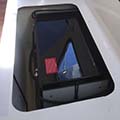 Lithium Battery |
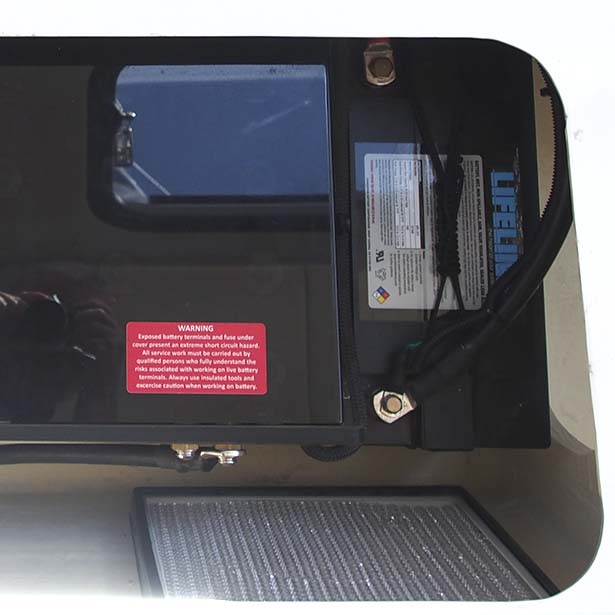 Start Battery |
| Battery Management System | ||
|
The Outback Marine battery management system is at the core of driving the vessel electrical system. Advanced battery monitoring in conjunction with control capability of the battery switches, charging and load functions ensures that the electrical system operates within a safe yet high performance envelope. Although the system was originally developed for Lithium batteries, it's just as home with other battery technologies including AGM and Gel. The all digital system communicates with modules on the DC distribution board to measure battery voltage, current, BMS status and temperature along with control capability. Remote battery switching, cross charging and inverter charger control is directly accessible through dedicated control keys on the front panel. Solar panel data is accessed from the Victron solar regulator. By keeping track of battery usage data over the last 24 hours, a better insight into the electrical system operation can provide an outcome of less energy consumption and faster charge cycles. Longer term battery data can identify cycle and depth of discharge patterns. This data is immediately availble on the graphic LCD display or can be viewed on the free OMAlink iPhone app. Download now and ckeckout the demo mode. |
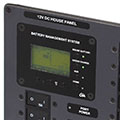 Lithium Controller |
|
|
|
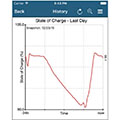 OMALink iOS App |
|
| Battery Charging | ||
|
The vessel has three main battery charging sources. For solar charging six 120 watt solar panels feed through a Victron MPPT solar controller. On a fine day the the vessel is self sufficient. The engines directly charge the AGM cranking battery and charge the Lithium bank through a cross charge relay. The Outback system allows the retention of the standard engine alternators however larger alternators can be fitted for accelerated charging. A diesel generator can charge at 120 amps through the Victron Multiplus inverter charger. The Lithium battery is fully protected by the Outback BMS. All charging sources can be isolated in case of overvoltage failure. In addition the inverter can be turned off for very low state of charge conditions. |
Lightwave 45 catamaran Tu Kanu launched in May 2016 fitted with Outback Marine electrical system.
- 540 AH lithium battery and management system
- Custom DC electrical panels
- Victron Energy system components

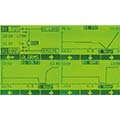





.jpg)